Paper: Food availability in spring affects smolting
Posted by Daniel Nyqvist | NyheterDouglas A. Jones har tillsammans med Eva Bergman och Larry Greenberg från NRRV och Karlstads Universitet nyligen publicerat en artikel med titeln “Food availability in spring affects smolting in brown trout (Salmo trutta)”. Studien handlar om födotillgångens inverkan på smoltifiering hos öring där låg födotillgång under våren verkar leda till att en högre andel öringar smoltifierar under samma vår. Artikeln publicerades i tidskriften Canadian Journal of Fisheries and Aquatic Sciences. I abstractet skriver författarna:
“Prior to out-migration, salmonid fish typically undergo physiological and morphological changes — a process known as smolting. This study indicates that smolting in brown trout (Salmo trutta) is affected by feeding conditions in spring immediately prior to out-migration. This conclusion was reached after experimentally testing the effect of seasonal variation in food availability on smolt status in the spring. A migratory strain of trout was administered either high or low food rations in the autumn, winter, or spring prior to release in the spring. While fish growth or condition could be affected in any season, it was spring rationing that reduced growth and growth-related variables and that caused increased smolting. Our result supports the idea that smoltification and the decision to migrate is affected by spring food availability regardless of conditions in the previous autumn or winter.”
Ladda ner artikeln här. Har du inte tillgång till tidskriftens innehåll men ändå vill läsa artikeln, kontakta någon av författarna.






